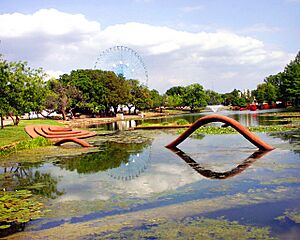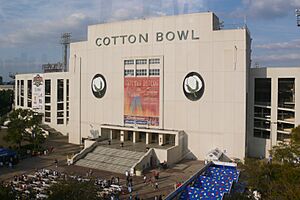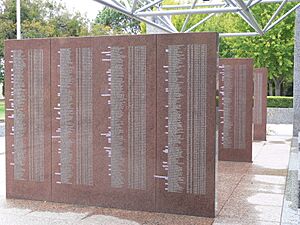Fair Park facts for kids
|
Texas Centennial Exposition Buildings (1936–1937)
|
|

Centennial Building in Fair Park
|
|
| Location | Bounded by Texas and Pacific RR, Pennsylvania, Second, and Parry Aves. Dallas, Texas, U.S. |
|---|---|
| Area | 277 acres (112 ha) |
| Built | 1936 |
| Architect | George L. Dahl, et al. |
| Architectural style | Art Deco |
| NRHP reference No. | 86003488 |
Quick facts for kids Significant dates |
|
| Added to NRHP | September 24, 1986 |
| Designated NHLD | September 24, 1986 |
Fair Park is a fun and educational place in Dallas, Texas. It is just east of downtown Dallas. This huge area, about 277 acres, is a special Dallas Landmark and a National Historic Landmark. Many of its cool buildings were built for the Texas Centennial Exposition in 1936.
Fair Park is even called a "Great Place in America" by the American Planning Association. It's a place where history, culture, and fun come together!
Contents
Fair Park's Story: A Look Back in Time
Fair Park started as an 80-acre fairground in 1886. It was on the edge of East Dallas and hosted the Dallas State Fair. After a fire and money problems in 1904, people voted for a new plan. This made it Dallas's second public park, and it was named "Fair Park."
An important person in Fair Park's early design was George Kessler. He was a landscape architect and city planner. In 1906, he created the first official plan for the park. His ideas came from the City Beautiful Movement. This movement wanted cities to have beautiful public spaces. These included tree-lined streets, monuments, art, and fountains.
A very special year for Fair Park was 1936. This is when the Texas Centennial Exposition took place there. This big event lasted for six months. To get ready, the park changed a lot. Architects George Dahl and Paul Cret helped make it happen. The park went from an old fairground to an amazing Art Deco showplace. Many buildings were supposed to be temporary. But several of them are still standing today. They have been fixed up and look great. Over the years, the park grew to its current 277 acres.
In 1986, Fair Park was named a National Historic Landmark. It has one of the largest collections of old exposition buildings in the country. The Dallas Parks Department took over running the park in 1988. Today, many cultural places and yearly events bring millions of visitors. Most of these visitors come during the 24-day State Fair of Texas.
Keeping Fair Park Beautiful: Restorations and Plans
Many of the old Art Deco buildings have been restored. They now look like they did in 1936. They also have modern updates inside. For example, the historic Parry Avenue entrance gates were fixed in 2009. This was done for the Dallas Area Rapid Transit (DART) train service. The special carvings on the Centennial Building were cleaned in 2000. The Esplanade fountain and its large sculptures were also restored in 2004. Some sculptures were rebuilt and now have cool light and water shows.
In 2003, a big plan was made for Fair Park's future. This plan looked at how the park could be improved. It also suggested new activities and ways to manage the park. In 2006, the city gave $72 million for repairs and improvements.
In 2018, the Dallas City Council approved a new plan. A group called Fair Park First now helps manage the park. They work to make the park and the areas around it even better.
Fair Park's Cultural Corner: Museums and More
Many important Dallas cultural places are located right here in Fair Park.
- Hall of State
The Hall of State is managed by the Dallas Historical Society. They have exhibits inside that teach about Dallas history and culture. It's a great place to learn about the city's past.
- Old Mill Inn
The Old Mill Inn was one of the few buildings from the 1936 Exposition that didn't look Art Deco. It was built with stone and wood. It used to be an exhibit for the flour milling industry. Sometimes, it still serves as a restaurant in Fair Park.
- Magnolia Lounge and Margo Jones Theatre
This building was designed by architect William Lescaze in 1936. It brought a new style called European Modernism to Texas. It was a lounge for the Magnolia Petroleum Company. Next to it is the Margo Jones Theatre. This small theater honors Margo Jones, who started the first professional regional theater in the U.S.
- African American Museum
The African American Museum is on the same spot as the Hall of Negro Life from the 1936 Exposition. It has a permanent collection of art by famous African American artists. These include Romare Bearden, Jacob Lawrence, and John T. Biggers.
- The Leonhardt Lagoon
South of the Midway, there's a calm lagoon. George Dahl designed it to be a peaceful spot for visitors. In 1981, Patricia Johanson redesigned the lagoon. It is now known as a major earth sculpture. It also helps clean the water using natural methods.
- Museum of Nature and Science
The Museum of Nature & Science used to have two buildings around the lagoon. It also had a planetarium. Most of its exhibits moved to the new Perot campus in Victory Park in 2012. The old History Building at Fair Park is still open on weekends. It is a smaller part of the Perot Museum.
- Fair Park Band Shell
The Band Shell has cool, curved arches that show the Art Deco style. It has a stage building made of reinforced concrete. Lights surround the sloping outdoor theater, which can hold 5,000 people.
- Texas Discovery Gardens
This building was originally the Horticulture Building for the 1936 Exposition. It has been changed over time with new parts. This includes a modern glass conservatory. In the gardens, there's also a model home. The Portland Cement Company built it for the Exposition.
- Cotton Bowl
The Cotton Bowl stadium was built in 1930. It was first called "Fair Park Stadium." It has been made bigger over the years and can now hold 92,200 people. The Cotton Bowl Classic college football game was played here for many years. Today, it hosts the OU–TX game between the University of Oklahoma and the University of Texas. It also hosts the State Fair Classic game. The Dallas Cowboys football team played their first games here.
- Music Hall at Fair Park
The Music Hall was built in a Spanish colonial revival style. It was the General Motors Building during the Centennial Exposition. It was updated a lot in 1972. It used to be home to the Dallas Opera. Now, it is where the Dallas Summer Musicals perform.
- Women's Building
The Women's Building was first built in 1910 as a park coliseum. It was updated in the Art Deco style for the Centennial Exposition. Then, it was called the Hall of Administration. From 2000 to 2011, it was The Women's Museum. Now, it is used for special events and exhibits.
Fun Rides and Memorials
- The Texas Star is a giant Ferris wheel. It opened in 1985 and is one of the biggest in North America.
- The Texas Skyway opened in 2007. It's a cool gondola ride that takes you 65 feet above the ground. You get to see great views of the park.
- The Top o' Texas Tower opened in 2013. This 500-foot observation tower gives amazing views. It was a big part of a summer event that ran for one year.
- Fair Park is also home to the Texas State Vietnam Memorial. This memorial honors those who served.
Yearly Events: Fun for Everyone

- The biggest event at Fair Park is the annual State Fair of Texas. It has been held here since 1886. It lasts for 24 days. It starts on the last Friday in September and ends on the third Sunday in October. You can see Big Tex there!
Other Exciting Events
- The North Texas Irish Festival happens every year in early March. It's a celebration of Irish culture.
- Earth Day Texas takes place every April. It teaches people about protecting our planet.
- Fair Park Fourth is Dallas's yearly Independence Day celebration. It's a great place to watch fireworks!
Other Cool Things That Happened at Fair Park
- The 1936 movie The Big Show, starring Gene Autry, was filmed at Fair Park. You can see a lot of its buildings in the movie.
- In 1961, the musical movie State Fair was also filmed here.
- In July 1984, Fair Park became a Formula One race track for a weekend. It hosted the Dallas Grand Prix.
- In May 1988, Fair Park also hosted a Trans-Am Series race.
- The Nintendo World Championships were held at Fair Park in 1990.
- Fair Park and its museums were featured on the TV show North Texas Explorer in the early 2000s.
- An episode of the TV show Prison Break had scenes in Fair Park. It showed the mammoth statue and the Leonhardt Lagoon.
- In December 2013, a special fashion show by Chanel was held at Fair Park.
- In January 2021, Fair Park became a big center for COVID-19 vaccinations.
Getting to Fair Park
- Fair Park is easy to reach from I-30. This is a main highway through Dallas.
- You can also get to Fair Park by bus. Several bus routes by DART serve the area.
- DART's Green Line trains go to Fair Park. There are two stations: Fair Park station and MLK Jr. station. During the State Fair, DART runs extra trains to Fair Park Station.
Learning at Fair Park
The Irma Rangel Young Women's Leadership School is located right in Fair Park.
Images for kids










